Related Research Articles
The following list comprises significant milestones in the development of photography technology.

Victor Hasselblad AB is a Swedish manufacturer of medium format cameras, photographic equipment and image scanners based in Gothenburg, Sweden. The company originally became known for its classic analog medium-format cameras that used a waist-level viewfinder. Perhaps the most famous use of the Hasselblad camera was during the Apollo program missions when the first humans landed on the Moon. Almost all of the still photographs taken during these missions used modified Hasselblad cameras. In 2016, Hasselblad introduced the world's first digital compact mirrorless medium-format camera, the X1D-50c, changing the portability of medium-format photography. Hasselblad produces about 10,000 cameras a year from a small three-storey building.
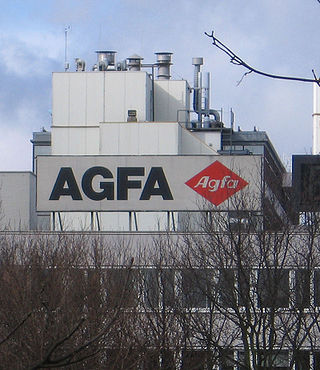
Agfa-Gevaert N.V. (Agfa) is a Belgian-German multinational corporation that develops, manufactures, and distributes analogue and digital imaging products, software, and systems.
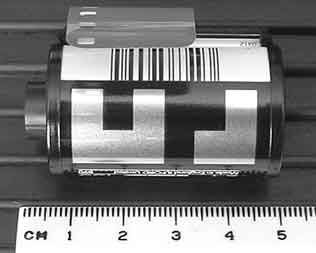
DX encoding is an ANSI and I3A standard, originally introduced by Kodak in March 1983, for marking 135 and APS photographic film and film cartridges. It consists of several parts, a latent image DX film edge barcode on the film below the sprocket holes, a code on the cartridge used by automatic cameras, and a barcode on the cartridge read by photo-finishing machines.
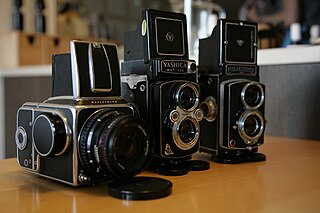
Medium format has traditionally referred to a film format in photography and the related cameras and equipment that use film. Nowadays, the term applies to film and digital cameras that record images on media larger than the 24 mm × 36 mm used in 35 mm photography, but smaller than 4 in × 5 in.

An image scanner—often abbreviated to just scanner—is a device that optically scans images, printed text, handwriting or an object and converts it to a digital image. Commonly used in offices are variations of the desktop flatbed scanner where the document is placed on a glass window for scanning. Hand-held scanners, where the device is moved by hand, have evolved from text scanning "wands" to 3D scanners used for industrial design, reverse engineering, test and measurement, orthotics, gaming and other applications. Mechanically driven scanners that move the document are typically used for large-format documents, where a flatbed design would be impractical.

Large format refers to any imaging format of 9 cm × 12 cm or larger. Large format is larger than "medium format", the 6 cm × 6 cm or 6 cm × 9 cm size of Hasselblad, Mamiya, Rollei, Kowa, and Pentax cameras, and much larger than the 24 mm × 36 mm frame of 35 mm format.

Konica Minolta, Inc. is a Japanese multinational technology company headquartered in Marunouchi, Chiyoda, Tokyo, with offices in 49 countries worldwide. The company manufactures business and industrial imaging products, including copiers, laser printers, multi-functional peripherals (MFPs) and digital print systems for the production printing market. Konica Minolta's Managed Print Service (MPS) is called Optimised Print Services. The company also makes optical devices, including lenses and LCD film; medical and graphic imaging products, such as X-ray image processing systems, colour proofing systems, and X-ray film; photometers, 3-D digitizers, and other sensing products; and textile printers. It once had camera and photo operations inherited from Konica and Minolta but they were sold in 2006 to Sony, with Sony's Alpha series being the successor SLR division brand.
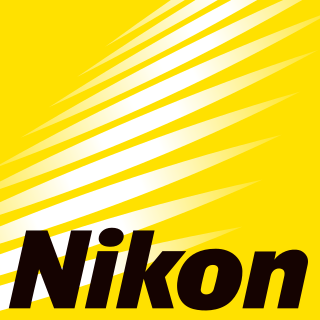
Nikon Corporation, also known just as Nikon, is a Japanese multinational corporation headquartered in Tokyo, Japan; it specializes in creating and marketing optics and imaging products. The companies held by Nikon form the Nikon Group.
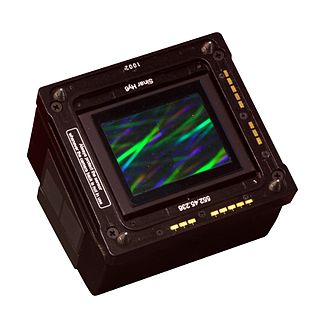
A digital camera back is a device that attaches to the back of a camera in place of the traditional negative film holder and contains an electronic image sensor. This lets cameras that were designed to use film take digital photographs. These camera backs are generally expensive by consumer standards and are primarily built to be attached on medium- and large-format cameras used by professional photographers.
Digital Negative (DNG) is a open, lossless raw image format developed by Adobe and used for digital photography. It was launched on September 27, 2004. The launch was accompanied by the first version of the DNG specification, plus various products, including a free-of-charge DNG converter utility. All Adobe photo manipulation software released since the launch supports DNG.

A digital single-lens reflex camera is a digital camera that combines the optics and the mechanisms of a single-lens reflex camera with a solid-state image sensor and digitally records the images from the sensor.
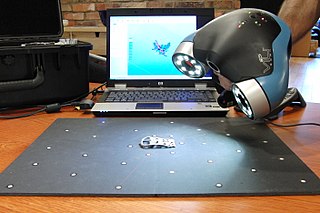
3D scanning is the process of analyzing a real-world object or environment to collect three dimensional data of its shape and possibly its appearance. The collected data can then be used to construct digital 3D models.
A camera raw image file contains unprocessed or minimally processed data from the image sensor of either a digital camera, a motion picture film scanner, or other image scanner. Raw files are so named because they are not yet processed, and contain large amounts of potentially redundant data. Normally, the image is processed by a raw converter, in a wide-gamut internal color space where precise adjustments can be made before conversion to a viewable file format such as JPEG or PNG for storage, printing, or further manipulation. There are dozens of raw formats in use by different manufacturers of digital image capture equipment.
Phase One is a Danish company specializing in high-end digital photography equipment and software. It manufactures open platform based medium format camera systems and solutions. Its RAW processing software, Capture One, supports many DSLRs besides their backs.

Scanography, more commonly referred to as scanner photography, is the process of capturing digitized images of objects for the purpose of creating printable art using a flatbed "photo" scanner with a CCD array capturing device. Fine art scanography differs from traditional document scanning by using atypical objects, often three-dimensional, as well as from photography, due to the nature of the scanner's operation.
The Fernseh AG television company was registered in Berlin on July 3, 1929, by John Logie Baird, Robert Bosch, Zeiss Ikon and D.S. Loewe as partners. John Baird owned Baird Television Ltd. in London, Zeiss Ikon was a camera company in Dresden, D.S. Loewe owned a company in Berlin and Robert Bosch owned a company, Robert Bosch GmbH, in Stuttgart. with an initial capital of 100,000 Reichsmark. Fernseh AG did research and manufacturing of television equipment.

LaserSoft Imaging AG is a software developer designing image processing software such as SilverFast for scanners and large format printers. The company's headquarters is located in Kiel, Germany, 100 kilometres (62 mi) north of Hamburg, and another office in Sarasota, Florida, United States.

SilverFast is the name of a family of software for image scanning and processing, including photos, documents and slides, developed by LaserSoft Imaging.
Artec 3D is a developer and manufacturer of 3D scanning hardware and software. The company is headquartered in Luxembourg, with offices also in the United States, China (Shanghai) and Montenegro (Bar). Artec 3D's products and services are used in various industries, including engineering, healthcare, media and design, entertainment, education, fashion and historic preservation. In 2013, Artec 3D launched an automated full-body 3D scanning system, Shapify.me, that creates 3D portraits called “Shapies.”
References
- ↑ Jacobs, Emma (2015-06-01). "This private library in Philly scans some of the world's most prized documents". Technical.ly Philly. Retrieved 2021-07-08.
- ↑ "Printing in Hong Kong 2013: Bright Arts on the Color-Separation Industry". PublishersWeekly.com. Retrieved 2021-07-08.
- ↑ "Digitalizzare ed elaborare le fotografie" (PDF). Archived (PDF) from the original on 2021-07-09.
- ↑ "Getty Museum's Open Content lets public download high-res art for free". Digital Trends. 2014-01-19. Retrieved 2021-08-03.
- ↑ Kammerer, Ann (February 11, 2015). "RCP offers high-end scanning and printing to Michigan artists". Capital Gains. Retrieved 2021-08-03.
- ↑ "Washington State Archives – Large Format Document Scanning". www.sos.wa.gov. Retrieved 2021-08-03.
- ↑ Berns, Roy S.; Smith, Stanley (2012-01-01). "Analysis of Color Management Default Camera Profiles for Museum Imaging Applications". Archiving Conference. 2012 (1): 111–115.